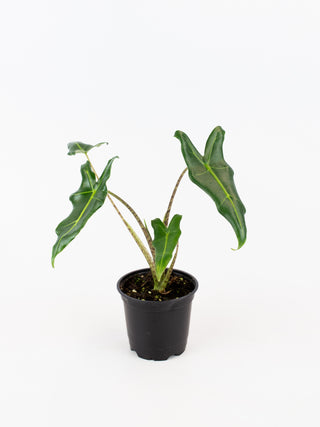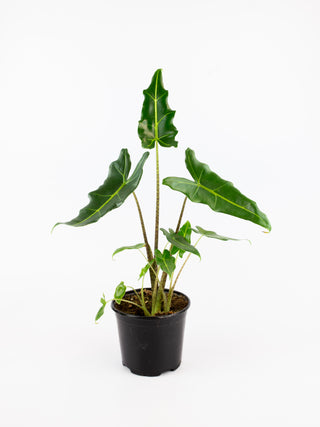A magnificent cross of our absolute favorite Alocasias: A. zebrina x A. 'Frydek'. These can get MASSIVE we've seen some standing about 6-8 ft tall with 3ft leaves. The ones we have available are in a 6" pot, and have roughly 3-4 leaves. As a lower leaf falls a new one unfurls. This process will eventually result in a trunk or stalk at the base of the plant as it mature further helping the plant stabilize itself in the soil.
Care
With most Alocasia you want to provide plenty of bright light. This could be dapple direct sun for about 1-2 hours such as morning light or just if you had a room that is bright filtered light for a majority of the day. Because they do like as much filtered light as they can get, Alocasia will naturally shift their orientation towards the light. Sometimes, if an Alocasia has more of an if your plant is drooping or has an 'umbrella' effect it is not always necessarily an indicator of being thirsty but an attempt to position itself to catch the most light. Overhead light will keep these nice and perky! They will like to dry out roughly 2-3" in the soil between waterings. When repotting, use a coarse well-draining soil.
All of our plants are ethically sourced from certified U.S. nurseries. We strongly condemn the poaching of plants or wild collection.
A magnificent cross of our absolute favorite Alocasias: A. zebrina x A. 'Frydek'. These can get MASSIVE we've seen some standing about 6-8 ft tall with 3ft leaves. The ones we have available are in a 6" pot, and have roughly 3-4 leaves. As a lower leaf falls a new one unfurls. This process will eventually result in a trunk or stalk at the base of the plant as it mature further helping the plant stabilize itself in the soil.
Care
With most Alocasia you want to provide plenty of bright light. This could be dapple direct sun for about 1-2 hours such as morning light or just if you had a room that is bright filtered light for a majority of the day. Because they do like as much filtered light as they can get, Alocasia will naturally shift their orientation towards the light. Sometimes, if an Alocasia has more of an if your plant is drooping or has an 'umbrella' effect it is not always necessarily an indicator of being thirsty but an attempt to position itself to catch the most light. Overhead light will keep these nice and perky! They will like to dry out roughly 2-3" in the soil between waterings. When repotting, use a coarse well-draining soil.
All of our plants are ethically sourced from certified U.S. nurseries. We strongly condemn the poaching of plants or wild collection.


